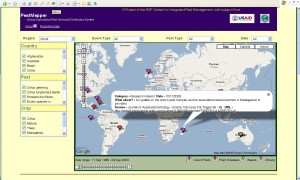Yesterday Hannes, à propos of something else, reminded me of a post I did a few months back about ProMED which asked the question “Why do we still not have an early warning system for genetic erosion?” Today I read about pestMapper — “[an] internet-based software tool for reporting and mapping biological invasions and other geographical and temporal events.” Whose objectives is basically to make a more participatory, Web 2.0-like ProMED. Coincidence? Maybe. Anyway, this is exactly the kind of thing we’ve been thinking here a “global genetic erosion threat reporting and monitoring portal” might look like. Any thoughts? An idea worth pursuing?

A system like this would allow us to assess local variety loss/replacement, but translating that to some measure of regional/global diversity is quite difficult in my eyes. I would think that a system that has other functions too (like seed exchange, variety recognition) would have a higher probability of success.
Another question: Are there some observable indications that we are approaching a tipping point in agrobiodiversity?
Agreed. Though we have to start somewhere, and the thing could be done in stages.
As for tipping points, we’d be looking for “catastrophic bifurcations” and “variance amplification” in the state of the system, if I understand it correctly. Well, certainly we do have a bifurcation in the way people think about the system, e.g. between proponents of GMOs and organic farming, for example. I don’t know if that counts.
The problem with local observations, I think, is that diversity is inherently about comparing varieties, etc. The disappearance of a variety in one place could have little effect on diversity, if it is common somewhere else. (The effect could even be positive, if you take evenness into account.) If, on top of that, you don’t know how variety names in one place correspond to varieties in another place, you are left with very little real information, even if you have a wealth of local observations.
However, if the system makes it possible to compare varieties according to traits (with some pictures) and perhaps some history (to trace the origin), the situation changes. The possibility of seed exchange could provide incentives for people to describe what they have and want in as much detail as possible. So perhaps it would be better to start “big” to make the circle round.
As for the tipping point question, I have thought a bit about it under the shower this morning. I think that an explosion of local varieties, for instance, could count as variance amplification. An increase in variety names could be due to a fragmented knowledge system with lots of redundancies (the same variety having different names in different places) as farmers fail to trace each variety. At a given moment, the names become meaningless. This can then lead to genetic erosion, as farmers fail to find certain varieties due to the name confusion. Less common varieties that survive by going from hand to hand will be the first to go extinct.
Has anyone observed this?
I like your thread on what an early warning system (agrobiodiversity) might look like — at first glance it seems like at truly daunting task (!), sort of like not being able to “see the forest for the trees”. It seems you’d have to have a hub approach — gather data locally in “hot-spots” where certain varieties are grown that feed into a central database to create the “big picture”, if you are talking about a global scale.
Of course you’d need massive buy-in for participation, unless you tap universities that are already tracking such events.
In my research on the origins of certain legume species I found that there is a huge drift in nomenclature for certain bean types — so much so that what you mention with regards to a name becoming meaningless is pretty close to being a reality!
See this for the confusion/controversy on Cannellini beans!
Thanks for your comments Patricia.
The whole question of common names — especially when one goes below species to varieties, cultivars, selections, landraces, what-have-you — is fraught with difficulties. There was a project at Melbourne University a while ago to compile a wiki-style multi-lingual dictionary of names, but I think it has stalled. Maybe the imminent age of 20-cent genome sequences will help, although I doubt it, given the variability in so many “heirloom” populations; see, for example, our recent post on heirloom tomatoes, and if there’s anything worse than a bean fanatic, it is probably a tomato fanatic.
My own feeling is that one should do the best one can to identify something, especially to species, and then just accept that there are difficulties with names.
I agree that names are difficult. But that doesn’t undermine the idea of early warning based on farmer knowledge and perceptions. An early warning system should only be able to indicate a broad risk of genetic erosion, not that variety X is going to be lost.
I think that broad trends in named farmer varieties can give at least an indication that something is going wrong.